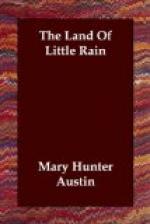Naboth has put a fence about the best of the field, but neither the Indians nor the shepherds can quite forego it. They make camp and build their wattled huts about the borders of it, and no doubt they have some sense of home in its familiar aspect.
As I have said, it is a low-lying field, between the mesa and the town, with no hillocks in it, but a gentle swale where the waste water of the creek goes down to certain farms, and the hackberry-trees, of which the tallest might be three times the height of a man, are the tallest things in it. A mile up from the water gate that turns the creek into supply pipes for the town, begins a row of long-leaved pines, threading the watercourse to the foot of Kearsarge. These are the pines that puzzle the local botanist, not easily determined, and unrelated to other conifers of the Sierra slope; the same pines of which the Indians relate a legend mixed of brotherliness and the retribution of God. Once the pines possessed the field, as the worn stumps of them along the streamside show, and it would seem their secret purpose to regain their old footing. Now and then some seedling escapes the devastating sheep a rod or two down-stream. Since I came to live by the field one of these has tiptoed above the gully of the creek, beckoning the procession from the hills, as if in fact they would make back toward that skyward-pointing finger of granite on the opposite range, from which, according to the legend, when they were bad Indians and it a great chief, they ran away. This year the summer floods brought the round, brown, fruitful cones to my very door, and I look, if I live long enough, to see them come up greenly in my neighbor’s field.
It is interesting to watch this retaking of old ground by the wild plants, banished by human use. Since Naboth drew his fence about the field and restricted it to a few wild-eyed steers, halting between the hills and the shambles, many old habitues of the field have come back to their haunts. The willow and brown birch, long ago cut off by the Indians for wattles, have come back to the streamside, slender and virginal in their spring greenness, and leaving long stretches of the brown water open to the sky. In stony places where no grass grows, wild olives sprawl; close-twigged, blue-gray patches in winter, more translucent greenish gold in spring than any aureole. Along with willow and birch and brier, the clematis, that shyest plant of water borders, slips down season by season to within a hundred yards of the village street. Convinced after three years that it would come no nearer, we spent time fruitlessly pulling up roots to plant in the garden. All this while, when no coaxing or care prevailed upon any transplanted slip to grow, one was coming up silently outside the fence near the wicket, coiling so secretly in the rabbit-brush that its presence was never suspected until it flowered delicately along its twining length. The horehound comes through the fence and under it, shouldering the pickets off the railings; the brier rose mines under the horehound; and no care, though I own I am not a close weeder, keeps the small pale moons of the primrose from rising to the night moth under my apple-trees. The first summer in the new place, a clump of cypripediums came up by the irrigating ditch at the bottom of the lawn. But the clematis will not come inside, nor the wild almond.




